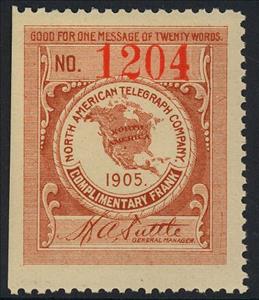Stamp: Map of North America - Frank - dated 1905 (United States of America 1905)
Map of North America - Frank - dated 1905 (United States of America 1905)
01 January (United States of America ) within release North American Telegraph Company goes into circulation Stamp Map of North America - Frank - dated 1905 face value Complimentary No Face Value
| Stamp Map of North America - Frank - dated 1905 in catalogues | |
|---|---|
| Stamp Number: | Sn: US 10T6 |
Stamp is square format.
With unique control number in red. Signature of the company's general manager, H. A. Suttle.Stamp Map of North America - Frank - dated 1905 it reflects the thematic directions:
A map is a symbolic depiction emphasizing relationships between elements of some space, such as objects, regions, or themes. Many maps are static, fixed to paper or some other durable medium, while others are dynamic or interactive. Although most commonly used to depict geography, maps may represent any space, real or imagined, without regard to context or scale, such as in brain mapping, DNA mapping, or computer network topology mapping. The space being mapped may be two dimensional, such as the surface of the earth, three dimensional, such as the interior of the earth, or even more abstract spaces of any dimension, such as arise in modeling phenomena having many independent variables. Although the earliest maps known are of the heavens, geographic maps of territory have a very long tradition and exist from ancient times. The word "map" comes from the medieval Latin Mappa mundi, wherein mappa meant napkin or cloth and mundi the world. Thus, "map" became the shortened term referring to a two-dimensional representation of the surface of the world.
Telegraphy is the long-distance transmission of messages where the sender uses symbolic codes, known to the recipient, rather than a physical exchange of an object bearing the message. Thus flag semaphore is a method of telegraphy, whereas pigeon post is not. Ancient signalling systems, although sometimes quite extensive and sophisticated as in China, were generally not capable of transmitting arbitrary text messages. Possible messages were fixed and predetermined, so such systems are thus not true telegraphs.


